News
Lasindu stands straight and tall
It could very well have been ‘touch and go’ ending in paralysis. On Thursday, as 16-year-old Lasindu Perera walks along the corridor between his Amma and Thaththa towards us, the wide smiles wreathing their faces tell a different tale.
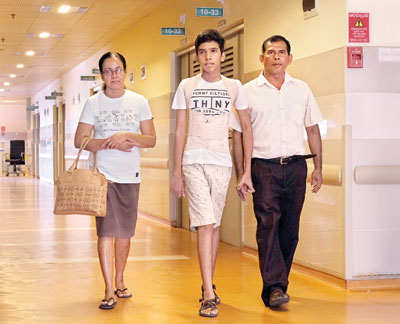
With the spine straight, Lasindu walks between Amma and Thaththa for the interview. Pix by Amila Gamage
It is only the braces around Lasindu’s chest and stomach that provide tell-tale signs that he has undergone some procedure but not the magnitude of the nearly 11-hour spinal surgery that has been performed on him by gifted and skilled hands, with the ‘Brain and Spine’ Team of the Asiri Central Hospital in Colombo being in attendance throughout.
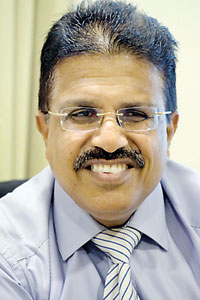
Dr. Sunil Perera
This is the first time that a neurosurgical team in the country has performed scoliosis-correction, the Sunday Times learns.
Severe abnormal curvature of the spine or scoliosis is what the Neurosurgical Team headed by Consultant Neurosurgeon Dr. Sunil Perera corrected, while Consultant Neurophysiologist Dr. Sudath Gunasekera watched closely whether there was even the slightest danger to the spinal cord and nerves which would end in paralysis and the Anaesthetist Team headed by Consultant Anaesthetist Dr. Rohini Ranwala walked a thin tightrope without being able to resort to the usual medications during this surgery.
The surgical and medical battle to keep Lasindu’s brain and spine healthy, however, began about 1½ years ago. This family of four from Katuneriya, close to Wennappuwa — Thaththa Camillus Perera in the Police Force dutifully keeping the home fires burning, Amma Chandima Fernando looking into the studies and extracurricular activities of the two children, Lasindu and younger sister, Dilmi – were happy and contented.

Dr. Rohini Ranwala
Lasindu attending Joseph Vaz College in Wennappuwa was an all-rounder. Mathematics was his favourite subject, while he was a very good athlete, hockey player, runner and long-jumper. That year (2016), he had come second in a long-jump event where athletes from all over the district participated.
Amma re-lives the trauma of how suddenly Lasindu got high fever once and excruciating headaches especially in the night. “Oluwe paththak allagena kegehewwa” (he used to hold a side of his head and scream in agony), while vomiting. They showed him to a doctor who said it was sema (phlegm) and treated him and gradually, oluwe amaruwa nethiwuna (the splitting headaches stopped).
Much later, during an English tuition lesson, his Master noticed that Lasindu could not hold up his book, says Amma, while Thaththa adds that he was also complaining of his right hand being “hiri-wetila” (numb). The Master suggested that they see Dr. Sunil Perera.
They then consulted Dr. Perera who immediately asked Lasindu to get some tests including Magnetic Resonance Imaging (MRI) of the brain done. The results were a shock as Thaththa was told that Lasindu had a big tumour on the left side of his brain and surgery was the immediate need. “Mage kakul deka pana nethi vuna,” says Thaththa, still shuddering at the thought, explaining that his legs felt lifeless.
The brain surgery for tumour-removal was on September 28, 2016 and Dr. Perera says that the tumour was in a hardly-accessible spot, in the thalamus and brain-stem. By the time they consulted him, Lasindu was already having slight paralysis on the right-side of his body, but was able to write because he is a left-hander.
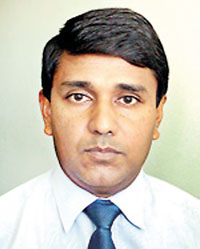
Dr. Sudath Gunasekera
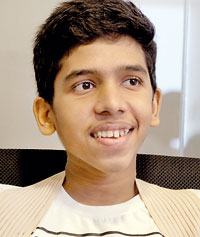
Lasindu is all smiles
“The brain surgery was a complete success,” says Dr. Perera, pointing to pre-op and post-op MRIs, showing us that “the white ball is gone” in the subsequent MRIs. The family went home happily not realizing that more agony and trouble were coming their way.
Lasindu resumed his lessons but with a weakness on the right side, he was tilting to a side when walking, says Amma, with other ills starting too such as hathiya (heavy panting) as if he had run many miles very fast. The family began dreading the evenings and nights as he was in severe pain.
In January, this year, they came back to Dr. Perera who promptly diagnosed scoliosis and promised them that he can “konda kelin karanna”, while gently telling them that it was a complex surgery.
On March 14, that is what Dr. Perera and his team did, while the parents made vows at the nearby Fatima Church for Lasindu’s recovery. This Thursday, Thaththa, Amma and Lasindu were back for his check up which has been satisfactory and also to say a heartfelt thank-you to the doctors who they say are “mihipita devivaru” (gods on earth) and each and everyone not only of the nursing but also the administrative staff who literally held their hands in their hour of need.
“Not a cent did the doctors charge,” says Thaththa with much emotion and as a tiny gesture of their gratitude, they have brought a beautiful ‘Thank-you card’ made with a lot of love by Lasindu’s sister for Dr. Perera.
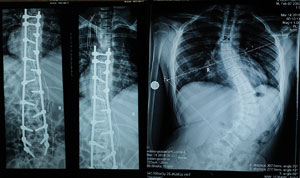
The 70 degree curvature of Lasindu’s spine (right) and after correctional surgery with screws (left)
| Urgent need to reduce patient numbers Scoliosis correction is difficult and complex surgery and the Sunday Times learns that it is Consultant Orthopaedic Surgeon, Dr. Vasantha Perera, who initiated these operations in Sri Lanka some time ago. Earlier, Dr. Randunna Corea who was based in West Asia had been performing a different method in Sri Lanka whenever he was in the country not however to correct the curvature through surgery but to keep the spine-bend from getting worse, said Dr. Sunil Perera, explaining that it entailed placing two rods, with the spine in the middle, with hooks at the upper and lower end keeping the rods fixed firmly. Paying tribute to Dr. Vasantha Perera, he says that this Orthopaedic Surgeon introduced surgery for the correction of scoliosis and is till performing about 30 operations a year. However, the prevalence of scoliosis is estimated to be 3% of the population each year. Dr. Sunil Perera who has worked with Dr. Vasantha Perera on scoliosis surgery earlier, points out that in America it is routine surgery with 35,000 undergoing this procedure each year. As Sri Lanka cannot meet the demand for these operations, many patients are compelled to seek them in India, not only spending exorbitant sums of money but also with poor follow-up. It is to reduce the patient burden that Dr. Sunil Perera in the past 10 years visited some of the centres of excellence for scoliosis-correction across the world. The whole team of Asiri Central Hospital had also visited Malaysia recently to hone their skills under the expertise of a surgeon who does 150 such operations each year. Now the Asiri Central Team is ready to help reduce the number of patients suffering from scoliosis. | |
| Complex procedure and tough role of the Anaesthetist The curvature of Lasindu’s spine was huge, we see from the X-rays up on the wall, with Consultant Neurosurgeon Dr. Sunil Perera explaining that the contributory causes were the weakness on his right side along with the growth spurt he was in as a teenager, being aggravated by the force of gravitation. “Lasindu’s spine was taking an ‘S’ shape and when we measured the curvature angle it was a vast 70 degrees. At 10 degrees, it is diagnosed as scoliosis and surgery is recommended when the curvature is over 40 degrees,” says Dr. Perera. Many issues are linked to scoliosis, the Sunday Times understands, with one being cosmetic appearance as the body is angled to one side, the pelvis is tilted and one shoulder is higher than the other, forcing the person to walk with a wobble. There is also much pain when walking or sitting, with more woes following. As the curvature gets worse, the lung capacity is affected and the person has difficulty in breathing. “When the curvature is more than 65 degrees, severe respiratory problems occur,” says Consultant Anaesthetist Dr. Rohini Ranwala. Here lies the imminent danger, for a slight slip will leave the patient paralysed. This is why Consultant Neurophysiologist Dr. Sudath Gunasekera was in the Operating Theatre to carry out intra-operative spinal cord monitoring not hourly but every second. He would instantly alert Dr. Perera whether harm would be caused to the patient. It was the onerous responsibility of Dr. Ranwala, meanwhile, to monitor lung functions as well as cardiac issues that could arise due to poor lung functioning. Pre-op all tests including chest X-rays, ECG, echocardiogram, blood-gas assessments and general blood tests had been carried out and there were no significant issues. However, to allow Dr. Gunasekera to monitor and prevent damage to the spinal cord during the operation, she was compelled not to administer the usual anaesthetic drugs (to stop feeling pain) or muscle-relaxant inhalation agents. This was due to Dr. Gunasekera having to measure neuro-muscular activity through somato-sensory evoked potential (SSEP) and motor-evoked potential (MEP). Nitrous oxide gas as an analgesic (to relieve pain) and a delivery medium for the inhalation anaesthetic agent could also not be given and Dr. Ranwala was left only with two medications to ensure that the patient remained absolutely still during the surgery, was properly sedated and also pain-free. Another crucial task of the Anaesthetic Team which provides a lifeline to the patient was to make sure that blood pressure and oxygen are at optimum value for adequate perfusion of the spinal cord. |

